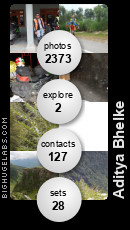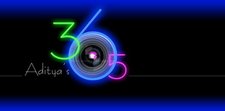Firstly the terms:
Mp = Mega Pixel. Never get anything below 3Mp. Photos using 3Mp can be used to get real, hard, photo-paper copies up to 5"x7" good quality prints. So higher MP is really needed if you want to print. Printing costs for 4"x6" is Rs.6; for 5"x7" approx Rs.10; for 8"x12" Rs.50.
Optical Zoom = Its the level of magnification one can get in the camera, using the optical lens system. Also called as wide angle - telescopic.
Digital Zoom = Don't even worry about this. Its just a marketing gimic; just don't consider this.
Modes = Auto modes are available on all models, gives best results under most conditions. Manual modes are useful to exploit camera features, and get best shots after calculating
shutter speeds, aperture,
focal length,
exposure compensation.
1]
Usage: Decide what the camera will be used primarily for.
-Home/People photography
3Mp+, 3x Optical Zoom, Auto modes
-Outdoor people photography
3Mp+, 3x Optical Zoom, Auto modes
-Landscape photography ( National Geographic)
6Mp+, 3x Optical Zoom, More zoom the better
-Birds/Animals (Animal Planet/ Discovery)
10Mp+, 10x Optical Zoom, max zoom is needed
-Professionals photography (fashion/glamor/travel/journalism) (F-Tv/news/
magazine)
6Mp+, 3x Optical Zoom,
DSLR only which can do
RAW images, lenses must be optical elements, detachable/changeable lens kits better.
-Macro (close up of Objects/Products/flowers)
5Mp+, Zoom mostly not needed
-Low light photography (Discovery, spy stuff)
5Mp+, DSLR preferred, higher ISO needed like 800, 1600, 3200.
2]
Mp or Zoom: Higher mega pixel or higher Optical Zoom
More Mp is needed if you intend to crop a lot of the frame. In that case 10Mp is the best. Cropping is hardly needed, perhaps for Pro photography.
On the other hand, having more optical zoom is better. You could take closer shots without actually moving close up to the subject.
3]
Battery:
Digital cameras suck batteries a lot. Getting a camera with a rechargeable battery is the only viable option. Two choices ..
- Proprietor battery pack (best option ever, bit costly)
- Rechargeable pencil cells (AAA or AA, cheap, but recharging needed very frequently)
4]
Movie modes:For a family camera, having a good movie mode is very desirable. That way a handy-cam is not needed. Look for 640x480 with minimum 24FPS modes (VCD quality). Higher the better. Any lower than this, the video will be jerky and grainy. AVI or MPEG video formats are preferable, and easy to edit and burn on DVD. MOV/quicktime may not so edit friendly. Also, DSLR's wont have movie modes.
5]
Others:LCD, don't get anything less than 2". Now a days 2.5" is standard and most desirable.
Memory, buy as much as you can afford. Minimum needed now a days is 512Mb, 1Gb recommended. But then you can always add more memory cards later if needed.
Size, now a days the slim models look great, and still perform very well, but are costlier. Do have a look at a camera in you hands and get a feel.
Shake reduction, or
Vibration reduction. Not a must have, but good for first time users, and ya it also helps when you zoom a lot.
Brand, I recommend Nikon and Canon. Sony and Kodak, are good too.
Want to check the internet for good deals and specs, click here and search in the customized Google search there. For buyers in India, I suggest you check prices and models on the JJmehta site too.
I own a Nikon D40 DSLR, a Canon A530, a Kodak CX6330 point and shoot (3Mp 3X, with video mode), an Acer 300 (300K pixel, 1st generation).
Let me know if you need any more info. I also recommend the Google Picasa photo management software. Also do visit my
365 Days Photo Project.
 Nowadays I'm getting influenced by Art. I have visited a lot of towns all over UK, and they all have great art galleries and museums, most of which have free entries. Initially I only used to visit them because they were free. But since the last few months, this free viewing has actually inspired me, to the point where I re-visited a couple of museums to look at the paintings there.
Nowadays I'm getting influenced by Art. I have visited a lot of towns all over UK, and they all have great art galleries and museums, most of which have free entries. Initially I only used to visit them because they were free. But since the last few months, this free viewing has actually inspired me, to the point where I re-visited a couple of museums to look at the paintings there. I look on the internet for help, and try to understand these paintings. They are after all 'photographs' of what the painter saw in his mind. It is then inspiring after interpreting a painting. I wonder how I might paint Vincent van Gogh's Cypresses even if I decide to copy it. Anyways, I don't think now is the time for me to paint.. may be when I'm older :)
I look on the internet for help, and try to understand these paintings. They are after all 'photographs' of what the painter saw in his mind. It is then inspiring after interpreting a painting. I wonder how I might paint Vincent van Gogh's Cypresses even if I decide to copy it. Anyways, I don't think now is the time for me to paint.. may be when I'm older :) With this new found understanding, that I'm a Classical when it comes to art, I reflect on my existing photos and I'm ashamed of what I see. All my work seems so childish... so 'nothing' compared to such great works. I have mixed feelings now.. I'm afraid of taking any more photos, as in my mind I have yardsticks set to great works of art. On the other hand these works of art inspire me to do better. Hope this inspiration translates into better photographs.
With this new found understanding, that I'm a Classical when it comes to art, I reflect on my existing photos and I'm ashamed of what I see. All my work seems so childish... so 'nothing' compared to such great works. I have mixed feelings now.. I'm afraid of taking any more photos, as in my mind I have yardsticks set to great works of art. On the other hand these works of art inspire me to do better. Hope this inspiration translates into better photographs.





